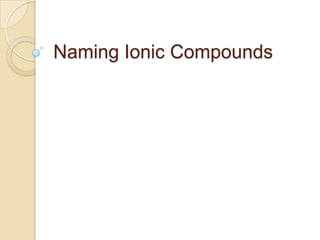
Ionic compounds naming
- 2. Monatomic Ions Made from a single atom gaining or losing an electron (based on valence electrons) Element Oxidation # Li +1 Be +2 O -2 F -1 Writing ions- write symbol, write charge as a superscript Ex. Al+3
- 3. Writing Ionic Compounds Made of two parts – cation & anion Name the cation first (typically a metal) just as it appears on periodic table Na+ Sodium Ca+2 Calcium
- 4. Writing Ionic Compounds with Transition Metals Most transition metals have more than one oxidation number If the transition metal has more than one oxidation number, you must represent it with a Roman Numeral in its name
- 5. Transition Metals to know Scandium column – always +3, no Roman Numeral needed F-block – always +3, no Roman Numeral needed Ag – always +1, no Roman Numeral needed Cd & Zn – always +2, no Roman Numeral needed
- 6. Transition Metals to know (cont.) Sn & Pb – either +2 or +4 Sn & Pb and all other transition metal’s oxidation # will be determined by “uncrossing the criss-cross” (I’ll explain in a minute) Examples: Fe+2 Iron II Fe+3 Iron III Al+3 Aluminum Cu+2 Copper II Cu+ Copper I Zn+2 Zinc
- 7. Writing Ionic Compounds (cont.) Write the anion next (typically a nonmetal) Change the ending to –ide Cl- , chlorine chloride O-2 , oxygen oxide **If the anion is a polyatomic ion, the name stays the same**
- 8. Writing Ionic Compounds Practice NaCl Sodium Chloride FeS Iron II Sulfide AlCl3 Aluminum Chloride Na2O Sodium Oxide Al2O3 Aluminum Oxide CuO Copper II Oxide
- 9. How to determine the Oxidation Number of Transition Metals Identify metal as a Transition with multiple oxidation numbers Uncross the “criss-cross” If nothing to uncross, identify the charge of the anion (they will always only have one oxidation number), charges have been simplified Transition metal charge is the same as anion charge (just +)
- 10. How to determine the Oxidation Number of Transition Metals (cont.) Ex. #1 Fe2O3 +3 -2 Fe2O3 Iron III Oxide
- 11. How to determine the Oxidation Number of Transition Metals (cont.) Ex.#2 FeS **No subscripts to show charge, so ID anion charge S = -2, therefore Fe must be +2 Name = Iron II Sulfide Ex.#3 CuO Name = Copper II Oxide
- 12. Writing an Ionic Formula Identify the charge on each part of the compound (cation and anion) Remember…the sum of the oxidation numbers MUST EQUAL ZERO Add subscripts to balance charges (can be done with criss-cross method)
- 13. Writing an Ionic Formula (cont.) Ex. #1 = Calcium Chloride Ions Ca = +2 Chlorine = -1 +2 -1 Ca Cl Formula = CaCl2 (Remember…never write 1’s)
- 14. Writing an Ionic Formula (cont.) Ex.#2 = Magnesium Oxide Ions Mg = +2 O = -2 Use “criss-cross” Mg2O2 **Simplify when possible MgO
- 15. Extra Rule Can’t change a Polyatomic Ions subscripts (if you need multiple polyatomics, you must put the ion symbol in brackets) Ex. PO4 = has a -3 charge Ca = has a +2 charge Formula = Ca3(PO4)2
- 16. Changes to Polyatomic Ions We must know the “root” polyatomic ion (the ones on our list) Oxygens can either be added or subtracted from the formula we know When that happens, the polyatomic ion name changes
- 17. Changes to Polyatomic Ions (cont.) 1 more oxygen per- -ate Root -ate 1less oxygen -ite 2 less oxygens hypo- -ite **the charge remains the same** Ex. SO5 = Persulfate SO4 = Sulfate